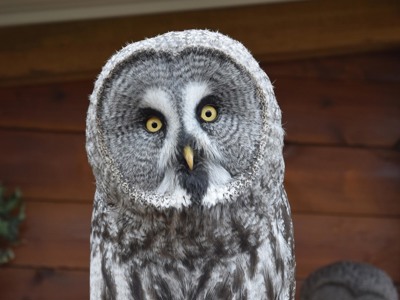
Great Grey Owl
Scientific name: Strix nebulosa
The Great grey owl’s scientific name, Strix nebulosa, refers to the bird’s screech (strix) and dark, cloudy colouration (nebulosa).
The Great grey owl has incredibly sensitive hearing which enables it to pinpoint the location of a sound. The bird’s hearing is improved by its large facial disk which acts like a satellite dish, funnelling sound to the owl’s ears. Their hearing is so good that they can hear a mouse’s heartbeat under several feet of snow!
This type of owl is crepuscular which means it mostly hunts at dawn and dusk. However, it may hunt in daylight hours or at night-time if food is scarce or if weather conditions are poor.
If breeding is successful, the female will incubate the eggs for 28 days. The male bird will provide food for the female during this time period. Owlets fledge (leave the nest) at around 8 weeks but remain close to the mother for several months before becoming fully independent.

-
We live...
In the Wings Of Wonder enclosure, next to the Ring Tailed Lemurs.
-
Size Fact
The Great grey owl is the biggest species of owl in the northern hemisphere.
-
Food Fact
They mostly eat small rodents and occasionally eat birds too.
-
Fun Fact
This bird is known to growl at its adversaries!
You might also like...
-
![Meerkats]()
Meerkat Keeper Talk
Come along and learn about our mob of Meerkats from our experienced animal keepers.
Find out more
-
![Zoe And Falcon]()
Bird of Prey Flying Display
Watch our majestic birds of prey in our new Wings of Wonder flying display.
Find out more
-
![Andean Bear]()
Bear Keeper Talk
Learn about our Spectacled bears from our experts and find out what it is like to be a Spectacled bear keeper.
Find out more
-
![African Elephant - Shaka 2]()
Elephant Keeper Talk
Did you know Elephants are the largest land animals on Earth? Come and join our Elephant Keepers and learn about our bulls.
Find out more






